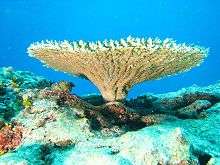Black coral
| Black coral | |
|---|---|
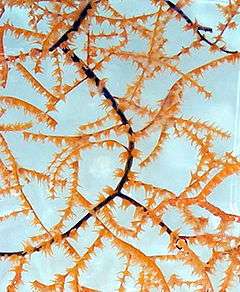 | |
| Black coral colony | |
| Scientific classification | |
| Kingdom: | Animalia |
| Phylum: | Cnidaria |
| Class: | Anthozoa |
| Subclass: | Hexacorallia |
| Order: | Antipatharia Milne-Edwards & Haime, 1857 |
Black corals (Antipatharia) are an order of deep water, tree-like corals. Black corals were previously classified in the taxon Ceriantipatharia with the ceriantharians,[1] but were later reclassified under Hexacorallia.
Description and characteristics
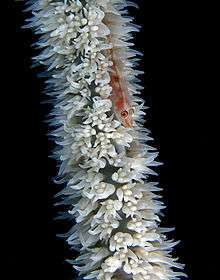
They normally occur in the tropics. They are also found in rather dark water areas such as New Zealand's Milford Sound where they can be viewed from an underwater observatory or via SCUBA diving. There are about 280 known species[2] of Antipatharians in 42 genera.[3] The surface of the colony is covered with living material, the coensarc, out of which the polyps project. These vary in size and shape, with those living nearer the holdfast being less elongated than those near the periphery. The polyps each have six non-retractable, unbranched tentacles.[4]
Though black coral's living tissue is brilliantly colored, it takes its name from the distinctive black or dark brown color of its skeleton.[2] Also unique to black coral are the tiny spines that cover the surface of the skeleton, the origin of the nickname little thorn coral.[2] In the Hawaiian language, black coral is called ‘ēkaha kū moana and is the official state gem of Hawaii.[5] Black coral is listed in Appendix II of the Convention on International Trade in Endangered Species (CITES) ,species that are not necessarily threatened with extinction, but may become so unless trade in specimens of such species is subject to strict regulation in order to avoid utilization incompatible with the survival of the species in the wild.
Lifespan
In March 2009, scientists released the results of their research on deep-sea (depths of ~300 to 3,000 m) corals throughout the world. They discovered specimens of Leiopathes glaberrima to be among the oldest living organisms on the planet: around 4,265 years old. They show that the "radial growth rates are as low as 4 to 35 micrometers per year and that individual colony longevities are on the order of thousands of years".[6][7]
Ecology
Whip coral (Cirrhipathes species) host as many as six other species. Whip coral gobies and barnacles permanently inhabit the skeleton. The goby and shrimp quickly hide on the skeleton's opposite side when a threat approaches. The goby and damselfish lay their eggs on the skeleton. The damselfish bites off the polyps to expose the nesting site.[8]
Harvesting
Black corals have historically been associated with mystical powers and medicinal properties,[9] though more recent harvesting has been for use as jewellery.[9][10] The best studied and regulated black coral fisheries are in Hawaii, where harvesting has been conducted since the 1960s.[9][11] In the Caribbean harvesting is typically conducted to produce jewellery for sale to tourists, and has followed a boom-and-bust cycle, where new black coral populations are discovered and overexploited leading to rapid declines.[9] For example, Cozumel, Mexico, was famed for dense black coral beds that have been harvested since the 1960s[12] leading to widespread black coral population declines.[13] Despite better black coral management in Cozumel, including no harvesting permits issued since the mid-1990s, the black coral population had failed to recover when assessed in 2016.[14]
Families
List of families according to the World Register of Marine Species :
- Family Antipathidae Ehrenberg, 1834
- Allopathes Opresko & Cairns, 1994
- Antipathes Pallas, 1766
- Cirrhipathes de Blainville, 1830
- Hillopathes van Pesch, 1914
- Pseudocirrhipathes Bo & al., 2009
- Pteropathes Brook, 1889
- Stichopathes Brook, 1889
- Family Aphanipathidae Opresko, 2004
- sub-family Acanthopathinae Opresko, 2004
- Acanthopathes Opresko, 2004
- Distichopathes Opresko, 2004
- Elatopathes Opresko, 2004
- Rhipidipathes Milne Edwards & Haime, 1857
- sub-family Aphanipathinae Opresko, 2004
- Aphanipathes Brook, 1889
- Asteriopathes Opresko, 2004
- Phanopathes Opresko, 2004
- Pteridopathes Opresko, 2004
- Tetrapathes Opresko, 2004
- sub-family Acanthopathinae Opresko, 2004
- Family Cladopathidae Kinoshita, 1910 >
- sub-family Cladopathinae Kinoshita, 1910
- Chrysopathes Opresko, 2003
- Cladopathes Brook, 1889
- Trissopathes Opresko, 2003
- sub-family Hexapathinae Opresko, 2003
- Heteropathes Opresko, 2011
- Hexapathes Kinoshita, 1910
- sub-family Sibopathinae Opresko, 2003
- Sibopathes Van Pesch, 1914
- sub-family Cladopathinae Kinoshita, 1910
- Family Leiopathidae Haeckel, 1896
- Leiopathes Haime, 1849
- Family Myriopathidae Opresko, 2001
- Antipathella Brook, 1889
- Cupressopathes
- Hydradendrium
- Myriopathes
- Plumapathes
- Tanacetipathes
- Family Schizopathidae Brook, 1889
- Abyssopathes Opresko, 2002
- Bathypathes Brook, 1889
- Dendrobathypathes Opresko, 2002
- Dendropathes Opresko, 2005
- Lillipathes Opresko, 2002
- Parantipathes Brook, 1889
- Saropathes Opresko, 2002
- Schizopathes Brook, 1889
- Stauropathes Opresko, 2002
- Taxipathes Brook, 1889
- Telopathes MacIsaac & Best, 2013
- Umbellapathes Opresko, 2005
- Family Stylopathidae Opresko, 2006
- Stylopathes Opresko, 2006
- Triadopathes Opresko, 2006
- Tylopathes Brook, 1889
 Cirrhipathes sp., an Antipathidae
Cirrhipathes sp., an Antipathidae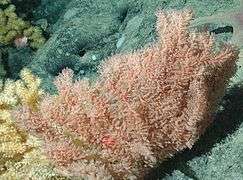 Trissopathes sp., a Cladopathidae
Trissopathes sp., a Cladopathidae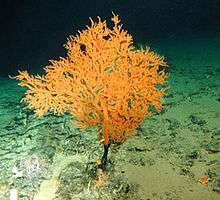 Leiopathes sp., a Leiopathidae
Leiopathes sp., a Leiopathidae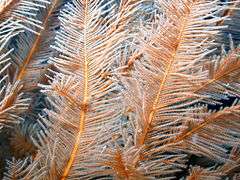 Plumapathes pennacea, a Myriopathidae
Plumapathes pennacea, a Myriopathidae Bathypathes sp., a Schizopathidae
Bathypathes sp., a Schizopathidae
References
- ↑ Appeltans, Ward (2010). "Ceriantipatharia". World Register of Marine Species. Retrieved 2017-12-21.
- 1 2 3 Opresko, Dennis. "Spotlight on Antipatharians (Black Corals)". NMNH.typepad.com.
- ↑ Tazioli, S., Bo, M., Boyer, M., Rotinsulu, H. & Bavestrello, G., 2007. Ecology of some common antipatharians from the Marine Park of Bunaken (North Sulawesi, Indonesia). Zoological Studies, 46, 227–241
- ↑ Colin, Patrick L. (1978). Marine Invertebrates and Plants of the Living Reef. T.F.H. Publications. pp. 294–299. ISBN 978-0-86622-875-6.
- ↑ Grigg, Richard W. (1993). "Precious Coral Fisheries of Hawaii and the U.S. Pacific Islands" (PDF). Marine Fisheries Review. Seattle, Washington: National Marine Fisheries Service, NOAA. 55 (2): 54. Retrieved 29 September 2010.
- ↑ Roark EB, Guilderson TP, Dunbar RB, Fallon SJ, Mucciarone DA (2009-02-10). "Extreme longevity in proteinaceous deep-sea corals". Proc Natl Acad Sci USA. 106 (13): 5204–8. doi:10.1073/pnas.0810875106. PMC 2663997. PMID 19307564.
- ↑ Graczyk, Michael (2009-03-25). "Scientists ID living coral as 4,265 years old". The Associated Press.
- ↑ Murphy, Richard C. (2002). Coral Reefs: Cities Under The Seas. The Darwin Press, Inc. ISBN 0-87850-138-X.
- 1 2 3 4 Bruckner, Andrew W. (2016), "Advances in Management of Precious Corals to Address Unsustainable and Destructive Harvest Techniques", The Cnidaria, Past, Present and Future, Springer International Publishing, pp. 747–786, doi:10.1007/978-3-319-31305-4_46, ISBN 9783319313030, retrieved 2018-07-04
- ↑ "The Biology and Ecology of Black Corals (Cnidaria: Anthozoa: Hexacorallia: Antipatharia)". Advances in Marine Biology. 63: 67–132. 2012-01-01. doi:10.1016/B978-0-12-394282-1.00002-8. ISSN 0065-2881.
- ↑ Grigg, Richard W. (2001-07-01). "Black Coral: History of a Sustainable Fishery in Hawai'i". Pacific Science. 55 (3): 291–299. doi:10.1353/psc.2001.0022. ISSN 1534-6188.
- ↑ Kenyon, J (1984). "Black coral off Cozumel". Sea Frontiers. 30: 267–272.
- ↑ Padilla, C., & Lara, M. (2003). Banco Chinchorro: the last shelter for black coral in the Mexican Caribbean. Bulletin of Marine Science, 73(1), 197-202.
- ↑ Gress, Erika; Andradi-Brown, Dominic A. (2018-07-04). "Assessing population changes of historically overexploited black corals (Order: Antipatharia) in Cozumel, Mexico". PeerJ. 6: e5129. doi:10.7717/peerj.5129. ISSN 2167-8359.
External links
- Opresko, Dennis. "Spotlight on Antipatharians (Black Corals)". NMNH.typepad.com.
- http://www.marinespecies.org/aphia.php?p=taxdetails&id=22549
- Antipathidae entry at Animal Diversity Web
- "Antipathidae". Integrated Taxonomic Information System.
- Mead, Gale (2001-06-08). "Research Expedition Aimed at Halting Loss of Black Coral". National Geographic News.
- "Black corals (Leiopathes spp.)". ARKive.
